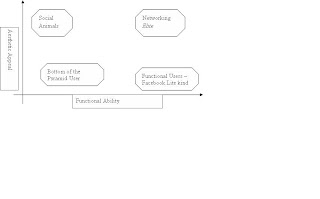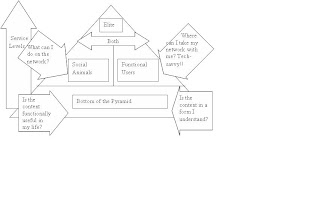======================================================================
“Any sufficiently advanced technology is indistinguishable from magic”
– Arthur C. Clarke
Indeed to a person from a few decades back, the idea of connecting with lost contacts, collaborating across geographical boundaries and obtaining expert advice on a universe of topics, all at the mere click of a mouse would have seemed magical.
Today we live in a world of increased connectivity, more computing power and more social networks. Originating as a fad across college campuses in the
As every individual discovers the power of “communities” and innovative entrepreneurs take notice of latent business opportunities, the question that begs answering is will social networking remain the same, even a few years down the line? Will it become a substitute for the human interaction just as the email has killed the picture postcards? In a culturally diverse country like
The user experience on any social networking site will arise from a set of contributing factors. Each user will find his ideal experience from a unique combination of these contributing factors. So while we do try to create a scenario for the ‘ideal’ user experience, our task should be list out the contributing factors and figure out how they interact with each other, how they can be tweaked for each user.
In trying to understand I tried to list down what I feel would be the contributing factors, please feel free to add on or debate upon any of the existing items. The factors are:
- accessibility – how do I get access to the platform
- UI -- how does it look when I log in and when I am using the platform
- Applications – okay so I have logged in, what do I do now, how engaged am I in the platform and what it has to offer.
- Security – How secure is my profile, my data and what control do I have over this exposure
- Network effect – how many people I know are on the platform, how connected am I with these people
- Diversity of the content – for 500 million people a plain English medium will not suffice nor will they be content with their preferred language
The accessibility is aspect would come into the picture because imagining a broadband penetration in
The apps part will include photo/video sharing, games, quizzes and other forms of content creation. This is an area where I feel lot of futuristic thinking is applicable and our survey findings have revealed insights into the broad fields on which the future apps could/would/should concentrate.
UI will be an important aspect of experience coz while it needs to be crisp and uncluttered it should also bring forth all the functionalities that are present on the platform and there is a potential use of analytics to see what kind of UI should be made available for what kind of user.
In the area of security we might be looking at futuristic account verifications like biometric systems, especially if we are talking about financial transactions happening on the platform.
As mentioned the network effect will involve my interaction with other members of the platform, my friends, family and members of online communities. The concept of collaboration and how futuristic we are in imagining the collaborative levels will determine how we use this factor to create the intended user experience.
Finally, diversity of content is a factor/challenge that is very India-specific because of our cultural diversity. I am looking at multi language support, real time context based translation and other such opportunities.
Unlike what I had set out to do in the beginning, writing about my ideal user experience, I thought this way of looking at the problem might also provide some insights to what we are trying to do.
What I have been unable to accomplish here is to state the interactions between various factors. For example, the more the modes of access, the greater will be the security risks. Similarly I think we can come up with more offsetting scenarios where some sort of compromise has to be struck. If you guys think this approach might lead some where then that would be a potential candidate for further analysis.
Once we have explicitly (or at least with some level of clarity) expressed the interaction levels of these factors, we might go about discussing how to tweak them to satisfy various user classes (we might have to do some user segmentation in this regard)
Apart from thinking of more ideas to enhance the social networking experience of the future network, I think it would also be a great value addition if we could provide a theoretical framework for future developers to understand how the network can be enhanced to improve the user experience.
Going back to the six factors which I had mentioned before the ideas, I feel we could land up with some kind of user segmentation on the basis of these factors. Thus, we can club the six factors into two major categories as follows:
a. the intangible/aesthetic aspect: consisting of the UI experience, content diversity and the network effect
b. functional aspect: consisting of accessibility, availability of apps (easy navigation) and security
Thus the total user experience = aesthetic appeal x functional ability
IDEAS
Carrying on from the above thoughts, I have few ideas, which can potentially improve the UI experience of the user and also be monetized for financial viability.
Theme based UI: Though theme based UIs are already available and for free, the idea is to link ads for theme related activities and goods with the themes to create a holistic package which will then be available to the user. While the user uses the theme for free, the theme creator gets paid by the advertiser and the platform gets a share of the revenue based on the usage of the particular theme. While the theme creator is free to invite as many advertisers on their themes, they have to balance it with keeping the UI experience simple and unobtrusive to ensure user acceptance.
For example, with the growing following of Barclay’s Premier League in
Online Partying: While social networking gurus contemplate on the latent potential of the network, the origins of the phenomenon still reside in the fun and bonding aspect. So it is not difficult to imagine the potential of organizing online parties on the social media, with the DJ and related effects. The party can be by invitation, where you might need to authenticate your navigation onto a webpage, or simply walk-in, or click-in, and open for everyone in the network. The monetization model is similar to how it works offline, with a host bearing the expenses. The party-page can be visualized as having a shoutcast app, another app to post requests to the DJ and apps to create visual effects on the webpage, which will be visible to others in the party.
Similar to the offline scenario, this can give rise to party/event managers specializing in services for this genre of partying. The online party will be especially interesting for
P.S.>> Sorry for the images.. cdnt do a better job!!!


No comments:
Post a Comment